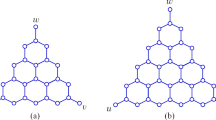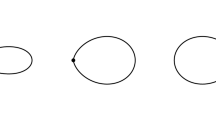Abstract
We construct an embedding of the space of electrical networks to the totally nonnegative Lagrangian Grassmannian in a generic situation with the help of the technique of vertex integrable models of statistical mechanics.

Similar content being viewed by others
References
A. Postnikov, “Total positivity, Grassmannians, and networks,” arXiv: math/0609764.
P. Galashin and P. Pilyavskyy, “Ising model and the positive orthogonal Grassmannian,” Duke Math. J., 169, 1877–1942 (2020).
T. Lam and P. Pilyavskyy, “Electrical networks and Lie theory,” Algebra Number Theory, 9, 1401–1418 (2015).
T. Lam, “Electroid varieties and a compactification of the space of electrical networks,” Adv. Math., 338, 549–600 (2018).
S. Chepuri, T. George, and D. E. Speyer, “Electrical networks and Lagrangian Grassmannians,” arXiv: 2106.15418.
B. Bychkov, V. Gorbounov, A. Kazakov, and D. Talalaev, “Electrical networks, Lagrangian Grassmannians and symplectic groups,” arXiv: 2109.13952.
A. B. Zamolodchikov, “Tetrahedra equations and integrable systems in three-dimensional space,” Soviet Phys. JETP, 52, 325–336 (1980).
S. Sergeev, “Private communication” (2020).
V. Gorbounov and D. Talalaev, “Electrical varieties as vertex integrable statistical models,” J. Phys. A: Math. Theor., 53, 454001, 28 pp. (2020).
E. B. Curtis, D. Ingerman, and J. A. Morrow, “Circular planar graphs and resistor networks,” Linear Algebra Appl., 283, 115–150 (1998).
E. B. Curtis and J. A. Morrow, Inverse Problems for Electrical Networks, (Series on Applied Mathematics, Vol. 13), World Sci., Singapore (2000).
A. Berenstein, A. Gainutdinov, and V. Gorbounov, “Private communication” (2021).
Acknowledgments
I am grateful to B. Bychkov, V. Gorbunov, and A. Kazakov for numerous discussions and especially to B. Bychkov for a careful reading of the text.
Funding
The work was partially supported by the “Basis” Science Foundation, the grant “Leader” (Math) 20-7-1-21-1 and the RFBR grant 20-01-00157A. This work was carried out within the framework of a development program for the Regional Scientific and Educational Mathematical Center of the Demidov Yaroslavl State University with financial support from the Ministry of Science and Higher Education of the Russian Federation (Agreement on provision of subsidy from the federal budget No. 075-02-2021-1397).
Author information
Authors and Affiliations
Corresponding author
Ethics declarations
The author declares no conflicts of interest.
Additional information
Translated from Teoreticheskaya i Matematicheskaya Fizika, 2022, Vol. 210, pp. 250-258 https://doi.org/10.4213/tmf10188.
Rights and permissions
About this article
Cite this article
Talalaev, D.V. Vertex electrical model: Lagrangian and nonnegativity properties. Theor Math Phys 210, 216–223 (2022). https://doi.org/10.1134/S0040577922020052
Received:
Revised:
Accepted:
Published:
Issue Date:
DOI: https://doi.org/10.1134/S0040577922020052




